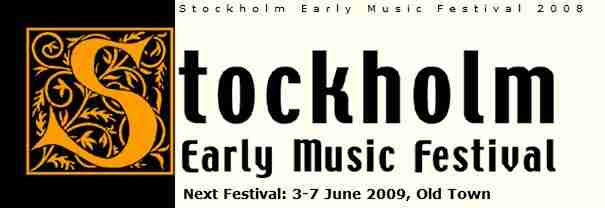
The Baroque ensemble, Auser Musici delivered a breathtaking performance on 08-JUN. The concert, Barocco Toscano, was part of the Stockholm Early Music Festival (SEMF), performed in the Finska Kyrkan (bak Slottet) in Gamla Stan.

Sveriges Television (SVT) did a superb job of miking and video production of the Auser Musici performance, without intruding on the delicate baroque music. A diagram of the SVT mics is shown below (mics are denoted by diagonal lozenge shapes).

SVT is the Swedish public service television company. SVT programming is non-commercial. Advertising is not allowed but sponsoring of sports events is. SVT’s programming covers the whole genre spectrum. In fact, 81 of the 100 most popular Swedish TV programs of 2007 were produced domestically by SVT, many of these as HD productions. I am not certain whether or not the SVT recording of Auser Musici at SEMF was in HD. But the SVT digital audio engineering was expert and insightful. Besides the cardioid-pattern mic near the open lid of the harpsichord, the SVT audio engineer also placed a contact mic inside the harpsichord (see photo, below).

The combination is a belt-and-suspenders approach that provides great phasing and extra mix-down options for the recording engineers, once the digital media are brought back to the studio. If one mic only were used, the tender harpsichord might be might be muddied by other nearby, stronger instruments. The insights gleaned from the excellent SVT production set-up were very valuable for those of us interested in recording and sound reinforcement of early music ensembles in churches or other boxy, deep performance venues.

The activity of the ensemble has grown over the past ten years and has recently been given institutional recognition as a project called Tesori Musicali Toscani [Tuscan Musical Treasures], supported by grants from the Italian government.
- Elena Cecchi, soprano
- Carlo Ipata, traverso (transverse baroque flute)
- Luca Ronconi, baroque violin
- Daniela Godio, baroque violin
- Teresa Ceccato, baroque viola
- Marco Ceccato, baroque cello
- Francesco Romano, theorbo
- Alfonso Fedi, harpsichord

Auser Musici arrange their musical programs in consultation with academic musicologists. The SEMF performance was just such a program, thoughtful yet emotionally accessible. Sonata, operatic and symphonic concerto forms were all represented, with works by Nardini, Traetta, and Cherubini, among others. The premise of Auser Musici’s program at SEMF was that music is itself a character, a protagonist in musical narrative—and that this feature was first grasped by composers of sacred and secular music in the early Baroque period. In other words, not only are individual character’s parts capable of rhetorical gestures, but instrumental sectional playing and tutti ensemble passages also embody ‘characters’ whose natures and motives are elucidated in the course of performing each work. The string section provides a narrative context for Cecchi’s arias for example. The whole ensemble functions as a kind of omniscient ‘narrator’, offering clues to the listener as the performance unfolds and presaging the outcomes of the various movements and passages.
Articles on Ipata and Auser Musici in magazines such as Klassik Heute, Early Music Magazine, Le Monde de la Musique, Repertoire, Diapason, and Goldberg reviewing Auser Musici’s recordings tend to highlight the excellent interpretive skills and beautiful playing. But the SEMF performance—apart from its aesthetic attractiveness—illustrated the importance of the scholarship of Auser Musici on Tuscan repertoire of the 17th and 18th Centuries in terms of discourse analysis, semiotics, and rhetorical practice. This is far, far from any ‘conventional-minded’ conception of musicology. Ipata and Auser Musici are showing us an innovative fusion of literary theory and music theory! Here they are, convincing us of the validity of their theses by virtuosic demonstration: “Sentire che dico a lei. Lí è! QED.”
Carlo Ipata’s lyrical and virtuosic playing on baroque flute was spectacular. (Ipata had his musical training first at the Banff Center in Canada, followed by the Royal Conservatory in Ajax, and finally at the Conservatory National de Region of Paris, where he got an honors diploma in baroque flute and chamber music. With the ensemble Suonatori della Gioiosa Marca, I Barocchisti, Il Capriccio, Seicentonovecento, and with AuserMusici, he has performed at the European Festival of Lubiana, the Italian Festival in Dortmund, Berliner Tage für Alte Musik, Festival Antiqua, Musikinstrumenten-Museum of Berlin, Festivoce (France), Celebrations of Boccherini in Madrid), and now SEMF. He has recorded for EMI, Amadeus, Agorà, Tactus, Bongiovanni, Symphonia, Hyperion.
As director of the Tuscan Musical Treasures Project, Ipata has collaborated with the Conservatory of the University of Cremona, the University of Pisa and the Scuola Normale Superiore, and the Italian Musicology Society. He is an author of ‘Il flauto in Italia’ ( Istituto Poligrafico dello Stato, 2005), and he has given courses and seminars at New York University. Ipata is Professor of Chamber Music at the Conservatorio Statale di Musica Gioacchino Rossini in Pesaro.

Here are links to a couple of MP3 tracks on Auser Musici’s website, to give you a feel for the musicianship and interpretive sensibilities of the ensemble:
No comments:
Post a Comment